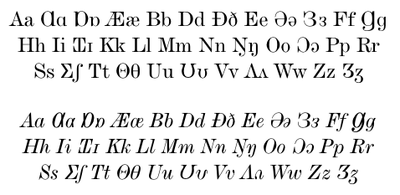Case variants of IPA letters

With the adoption of letters from the International Phonetic Alphabet (IPA) in various national alphabets, letter case forms have been developed. This usually means capital (upper-case) forms were developed, but in the case of the glottal stop ʔ, both upper-case ⟨Ɂ⟩ and lower-case ⟨ɂ⟩ are used.
The adoption of IPA letters has been particularly notable in Sub-Saharan Africa, in languages such as Hausa, Fula, Akan, Gbe languages, Manding languages, and Lingala. The most common are open o ⟨Ɔ ɔ⟩, open e ⟨Ɛ ɛ⟩, and eng ⟨Ŋ ŋ⟩, but several others are found. Kabiyé of northern Togo, for example, has ⟨Ɔ ɔ, Ɛ ɛ, Ɖ ɖ, Ŋ ŋ, Ɣ ɣ, Ʃ ʃ, Ʊ ʊ⟩ (or ⟨Ʋ ʋ⟩), as in this newspaper headline:
- MBƱ AJƐYA KIGBƐNDƱƱ ŊGBƐYƐ KEDIƔZAƔ SƆSƆƆ TƆM SE.
Some of the IPA letters that were adopted into language orthographies have since become obsolete in the IPA itself. And although one might think that the click letters ⟨ʘ ǀ ǃ ǂ ǁ⟩ were adopted from the IPA without case, the reverse happened: they were actually adopted into the IPA from Nama, replacing the dedicated IPA letters ⟨ʇ ʗ ʖ⟩; Nama never did have case for these letters.
Chart
| IPA | Uppercase | Lowercase |
|---|---|---|
| ɑ | Ɑ | |
| ɒ | Ɒ | |
| ɐ | Ɐ | |
| ɓ | Ɓ, Ƃ | |
| β | Ꞵ | ꞵ (IPA uses Greek beta still[2]) |
| ɔ | Ɔ | |
| ƈ | Ƈ | |
| ð | Ð | |
| ɖ | Ɖ, Ɗ | |
| ɗ | Ɗ | |
| (ᶑ | Ɗ̢) | Uses combining characters to represent uppercase ᶑ. |
| ə | Ə, Ǝ | |
| ɛ | Ɛ | |
| ɜ | Ɜ[3] | |
| ɡ | Ɡ[3] | |
| ɠ | Ɠ | |
| ɣ | Ɣ | |
| ħ | Ħ | |
| ɦ | Ɦ | |
| ɥ | Ɥ | |
| ɨ | Ɨ | |
| ɪ | Ɪ[4] | |
| ɩ | Ɩ | |
| ʝ | Ʝ | |
| ƙ | Ƙ | |
| ʞ | Ʞ | |
| ɫ | Ɫ | |
| ɬ | Ɬ[5] | |
| ɱ | Ɱ | |
| ɯ | Ɯ | |
| ŋ | Ŋ | |
| ɲ | Ɲ | |
| ƞ | Ƞ | |
| ɵ | Ɵ | |
| ƥ | Ƥ | |
| ɋ | Ɋ | |
| ɽ | Ɽ | |
| ʃ | Ʃ | |
| ʈ | Ʈ, Ŧ[6] | |
| ƭ | Ƭ | |
| ʇ | Ʇ | |
| ʉ | Ʉ | |
| ʊ | Ʊ | |
| ɷ | [7] | |
| ʋ | Ʋ | |
| ʌ | Ʌ | |
| ⱳ | Ⱳ | |
| χ | Ꭓ | ꭓ |
| ʒ | Ʒ, reversed Ʃ[4] | |
| θ | (like Θ)[4][6] | |
| ɸ | (like Φ) | |
| ʔ | Ɂ | ɂ |
Others letters are the graphic equivalent of IPA capitals, but are not identified with the IPA. Examples are ɟ Ɉ (actually, the capital of ɉ), ʎ (⅄) (the capital of λ in Americanist usage; similarly ƛ ),[6] ɹ ꓤ.
References
- ↑ Lewis Carroll, Alice's Adventures in Wonderland: an edition printed in the International Phonetic Alphabet. Cathair na Mart: Evertype, 2014.
- ↑ Michael Everson, 2012-07-26, Proposal for the addition of ten Latin characters to the UCS
- 1 2 Michael Everson, 2012-02-08, Proposal for the addition of five Latin characters to the UCS
- 1 2 3
- ↑ Joshua M Jensen, Karl Pentzlin, 2012-02-08, Proposal to encode a Latin Capital Letter L with Belt
- 1 2 3
- ↑
